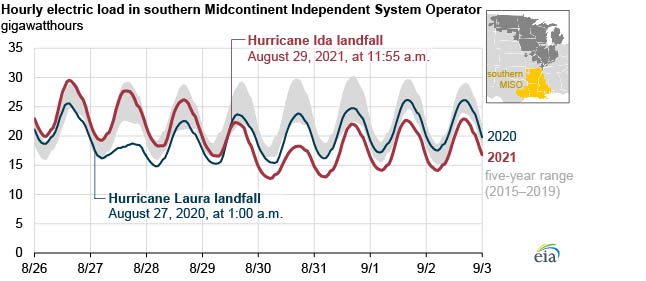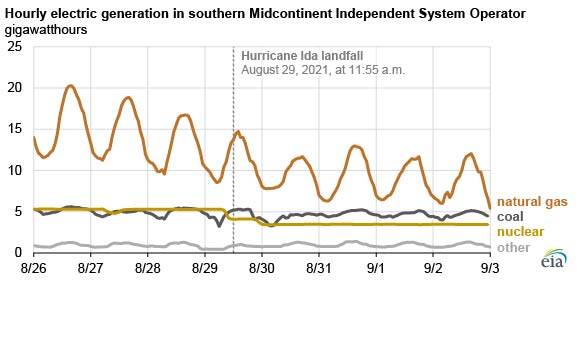
As Category 4 Hurricane Ida made landfall along the Southeast coast of Louisiana near New Orleans on August 29, 2021, the electric load in the southern region of the Midcontinent Independent System Operator (MISO) decreased. Hourly electric loads on August 30, the day after landfall, were about 25% to 30% lower than the average for that day of the year over the past six years. Southern MISO experienced a similar decline in electric load last year when Hurricane Laura made landfall.
The southern region of MISO consists of electricity service areas in Arkansas, Louisiana, western Mississippi, and eastern Texas. This region typically accounts for about one-quarter of electric load in MISO.
Damage to transmission and distribution lines caused by Hurricane Ida resulted in power outages for approximately 1.2 million customers in Louisiana and Mississippi. Entergy, one of the major power providers in the region, reported 210 transmission lines were out of service, including all eight transmission lines that deliver power into New Orleans. These transmission outages affected more than 2,000 miles of Entergy’s total 16,100 miles of transmission lines. The hurricane also damaged 220 of Entergy’s 1,300 substations. These substations convert high-voltage electricity carried over transmission lines to the lower voltage levels used for local distribution—a critical role.
Because of the electric load decrease caused by Hurricane Ida, electric generation in the southern MISO region was forced to drop by a corresponding amount to keep the grid in balance. Hourly nuclear generation decreased significantly, falling from 5.2 gigawatts (GW) on August 29 to 3.7 GW on August 30. The River Bend Station nuclear plant was cut back to 40% of its capacity. In addition, the Waterford 3 nuclear plant located 25 miles west of New Orleans was shut down as a safety precaution because of high winds on the morning of August 29.

Natural gas-fired power plants also reduced electric generation. Hourly natural gas-fired electric generation in the southern MISO region peaked at 20 gigawatts (GW) on August 26, but it only reached 12 GW on August 30.


Follow us on social media: